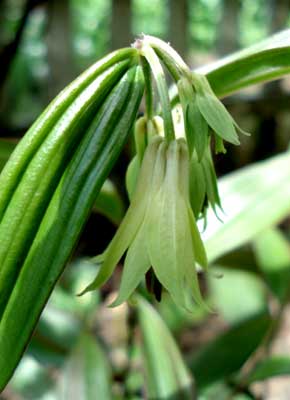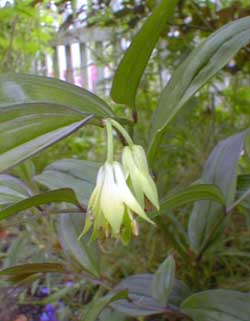
'DJHC 739'
Cantonese Fairybells
"The breathing flowers, the forest-buds unfurl'd,
Are not the expanded seedlings that we ween,
But sweet transfigurations from the world
That lies within the seen."
-Robert Leighton
(1806-1875 )
The species Disporum catoniense or Cantonese Fairybells has a high tendency to variation, with strains from different sources being quite different one to the next, though not all variations of have cultivar names.(1806-1875 )
There are varieties with red flowers & with pale yellow; with green leaves, variegated leaves, or purple leaves; with upright stems or arching stems; tall & loosely leafed, or short with denser foliage.
 We began with two seedlings which had been started at our local yet world-famed Heronswood Nursery. Dan, the original owner, collected the original seeds in 1996 in Sichuan Province, & designated these 'DJHC 739.
We began with two seedlings which had been started at our local yet world-famed Heronswood Nursery. Dan, the original owner, collected the original seeds in 1996 in Sichuan Province, & designated these 'DJHC 739.From among the very first batch that Heronswood sprouted, three seedlings had unusually intense purple throughout the leaves. The best of these three purple-leafed specimens was further cultivated to produce 'Night Heron' Fairybells.
We obtained one each of 'DJHC 739' & 'Night Heron' & planted them side-by-side in a shade garden overshadowed by 'Diablo' Ninebark. The greenleaf Cantonese fairybells alongside the chocolate-blackleaf form provide a striking contrast.
The yellow or cream-white flowers begin in April when the stalks & leaves are only partially mature, & continues flowering into summer as the clump of upright bamboo-like stems rises to about four feet (six feet on a long-established colony).
The clump or colony gets broader each year by rhizomitous spread, but it is not generally aggressive toward other plants. The pendant fairybells are followed by black berries which are showier than the blooms. These berries are not edible.
The flowers & fruits on half-inch penduncles on the undersides of the leaves are attractive, but it is the olive-green stems & light green foliage that is most prized, having leaf-arrangements that make it a fine bamboo substitute for looks. It's also a bit like its close relative, Solomon's Seal, but rigidly upright rather than fountaining like Solomon's Seal.
It wants dappled sunlight or shade & moist well-draining humusy soil, in containers or the open garden. In our mild climate, in its protected spot, it is largely evergreen through winter without much damage, but even so should be cut back just before spring to make room for fresh new growth.
Disporum flavum, Korean Fairybells